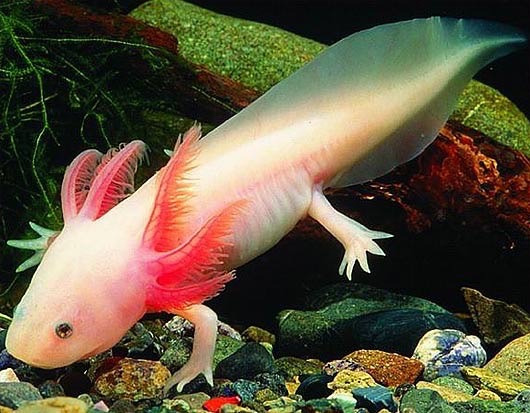The axolotl, also known as a Mexican salamander or a Mexican walking fish, is a neotenic salamander, closely related to the tiger salamander. Although the axolotl is colloquially known as a "walking fish", it is not a fish, but an amphibian.
The species originates from numerous lakes, such as Lake Xochimilco underlying Mexico City. Axolotls are unusual among amphibians in that they reach adulthood without undergoing metamorphosis. Instead of developing lungs and taking to land, the adults remain aquatic and gilled.
As of 2010, wild axolotls were near extinction due to urbanization in Mexico City and consequent water pollution. They are currently listed by CITES as an endangered species and by IUCN as critically endangered in the wild, with a decreasing population.
Axolotls are used extensively in scientific research due to their…
ability to regenerate limbs.
Axolotls have barely visible vestigial teeth, which would have developed during metamorphosis. The primary method of feeding is by suction, during which their rakers interlock to close the gill slits. External gills are used for respiration, although buccal pumping (gulping air from the surface) may also be used to provide oxygen to their lungs.
The axolotl is only native to Lake Xochimilco and Lake Chalco in central Mexico. Unfortunately for the axolotl, Lake Chalco no longer exists, as it was artificially drained to avoid periodic flooding, and Lake Xochimilco remains a remnant of its former self, existing mainly as canals. The water temperature in Xochimilco rarely rises above 20 °C (68 °F), though it may fall to 6 to 7 °C in the winter, and perhaps lower.
The wild population has been put…

under heavy pressure by the growth of Mexico City. The axolotl is currently on the International Union for Conservation of Nature's annual Red List of threatened species. Non-native fish, such as African tilapia and Asian carp, have also recently been introduced to the waters. These new fish have been eating the axolotls' young, as well as its primary source of food.
The axolotl is carnivorous, consuming small prey such as worms, insects, and small fish in the wild. Axolotls locate food by smell, and will "snap" at any potential meal, sucking the food into their stomachs with vacuum force.
Axolotls exhibit neoteny, meaning they reach sexual maturity without undergoing metamorphosis. Many species within the axolotl's genus are either entirely neotenic or have neotenic populations. In the axolotl, metamorphic failure is caused by a lack of thyroid stimulating hormone, which is used to induce the thyroid to produce thyroxine in transforming salamanders.
The axolotl is a popular exotic pet like its relative, the tiger salamander. As for all poikilothermic organisms, lower temperatures result in slower metabolism and a very unhealthily reduced appetite. Temperatures at approximately 16 °C (61 °F) to 18 °C (64 °F) are suggested for captive axolotls to ensure sufficient food intake; stress resulting from more than a day's exposure to lower temperatures may quickly lead to disease and death, and temperatures higher than 24 °C (75 °F) may lead to metabolic rate increase, also causing stress and eventually death.
Chlorine, commonly added to tapwater, is harmful to axolotls. A single typical axolotl typically requires a 40-litre (11-US-gallon) tank with a water depth of at least 15 cm (6 in). Axolotls spend a majority of the time at the bottom of the tank.
Salts, such as Holtfreter's solution, are usually added to the water to prevent infection.
In captivity, axolotls eat a variety of readily available foods, including trout and salmon pellets, frozen or live bloodworms, earthworms, and waxworms. Axolotls can also eat feeder fish, but care should be taken as fish may contain parasites.
Below we feature a great video that shows and teaches you about axolotls. Watch the clip and share this article with your friends who love animals!

